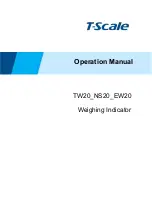
25
Verifying Connections Using ATPOL II (SureStart
TM
)
Importance of Verifying Connections and Wiring
After connecting to power, it is wise to check that everything is connected correctly and that the wiring
of the facility is correct. There are two primary methods for doing this. You may either send waveforms
from ATPOL II to your PC and visually check that all connections are correct and all signal levels and
shapes appear correct (see the
Verifying Connections using PSM
section), or you can easily use the
patented SureStart
TM
feature within ATPOL II to quickly and easily do this.
The importance of having all connections and settings correct cannot be overstated. If connections are
not correct, important decisions may be made based on erroneous data or logging sessions lasting
several weeks may have to be repeated. Common connection and setup errors and their negative
results are:
Current probe attached backwards.
Normally, if current probes are attached backwards, ATPOL
II senses this and turns them around in software so you still get the correct power readings. This is
one of the features that makes ATPOL II easy to use. However, if you view waveforms and a
current probe is backwards, that current will appear upside down (180 degrees out of phase). More
importantly, if ATPOL II is in the Positive/Negative Power measurement mode, a backwards current
probe will have a disastrous effect on the power, KWH, and cost readings (typically the display will
present 1/3 of the correct value).
Voltages and currents of the same phase not paired together.
If the V
1
voltage probe is
connected to the phase 1 voltage, but the I
1
current probe is attached to the phase 2 or phase 3
current, large errors will occur in measurement of power and power factor. For instance in a
perfectly balanced three-phase system with 0.92 power factor and no harmonics, if the connections
of the I
1
and I
3
probes are switched, the true power will fall 33% and the power factor of each phase
will become .12, .92, and .80.
Current probe not fully connected to ATPOL II.
The current probe connector needs to be fully
seated within its socket. If it is not, the reading may be 0 (resulting in a loss of about 1/3 of the
power of a three-phase system), the probe may be misidentified (resulting in current readings of a
fraction or a multiple of the correct value), or the display may say “I
1
input too large” and ATPOL II
will refuse respond to any keypad button.
Voltages not connected.
If one or more of the voltage probes is not connected properly, test
results for voltage, power, and power factor will be very inaccurate. Typically power will be off by
much more than 30% in a three-phase system
Circuit not energized.
If one or more of the phases is not energized, then any logging session will
be a waste of time.
Incorrect frequency measurement mode.
If ATPOL II is set for fixed 50 Hz operating mode but
the circuit is actually 60 Hz, all measurements will be erratic and will vary from second to second.
Similarly, if it is set for fixed 60 Hz, but you are measuring a variable speed drive operating at 55
Hz, the results will be erratic and vary from second to second.
Non-standard voltages or phase angles
. If there are unusual voltages or inter-phase angles, the
circuit that is being monitored is suspect. There may be a problem with the equipment or power
service that should be understood before a logging session begins.
SureStart
TM
is a patented technology that does a better job of identifying connection and setup
problems than you can expect an expert to do. To use the SureStart feature, press the [Verify
Connections] key on the top row of the keypad. It does a complete analysis of the power signals and
Содержание ATPOL II
Страница 109: ...109...
















































